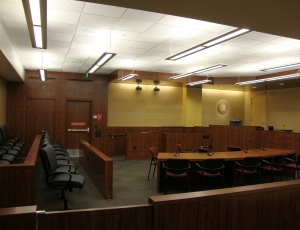Turner Construction recently completed the B.F. Sisk Courthouse project in Fresno three months ahead of schedule and $4 million under budget.

Turner provided construction management at risk services for the $54.9-million B.F. Sisk Courthouse renovation.
The courthouse is an existing five-story, 191,886-sq-ft reinforced concrete building with a basement. The building has served since its construction in 1967 as the Federal Building and U.S. Courthouse.
Turner Construction, together with SmithGroup architects, renovated the former federal courthouse into a state courthouse for the Administrative Offices of the Courts. Work included demo of the interior floors one through five and building out 15 new courtrooms, judge chambers and support offices.
�Bringing this project to fruition three months ahead of schedule was no easy task,� says project executive Barry Owens.
He adds that there were many obstacles that the project team had to overcome, such as �building access, problems during demolition, hazmat abatement, seismic retrofit and limited floor to floor height.�
Major interior renovation work included new or major improvements to the life safety, mechanical, electrical, voice-data and security systems. Structural improvements would include an incremental increase to the seismic rating based on the California DSA rating system.
The project utilized 90% to 100% recycled materials.
Rutherford and Chekene of San Francisco served as structural engineer.
Because the courthouse was built to mid-1960�s standards, it had unusually low ceiling heights (12-ft, 6-in. and a normal courthouse today has a 15- to 17-ft floor-to-floor height).
Owens says a modern courthouse building needs �quite a bit� of ceiling space for air-delivery systems, and this project offered little.
�We had to deal with the problem in the most effective way that we knew and that was to use BIM,� Owens says. �So we took the architect drawings and converted them into 3-D and then we modeled the entire project, while working closely with the design team.� Once the project was modeled, he says crews were able to work the air and mechanical systems around the perimeters of the courtrooms instead of directly overhead.
Owens says BIM also assisted in seismic upgrading on the fifth floor. He says that in this area, the structural engineer selected a carbon fiber enclosure to seismically upgrade the columns. �This stuff replaces the steel-jacketed column wraps that are seen on highway bridges and things of that nature,� he adds.
He says crews used the wrap on about 28 columns on the top floor, and the rest of the building was reinforced with concrete in-fills in various existing openings, such as stairways, duct openings and shear walls.
The Sisk building was vacated in 2005 when the Robert E. Coyle United States Courthouse was dedicated. The federal government then agreed to convey title for $1 for use by the Superior Court with the stipulation that the building be used for the administration of justice.


Post a comment to this article
Report Abusive Comment